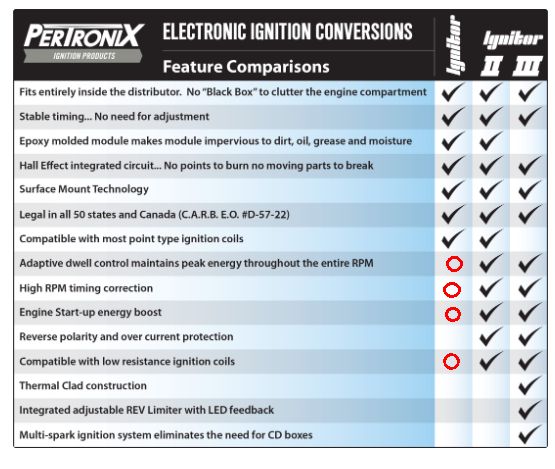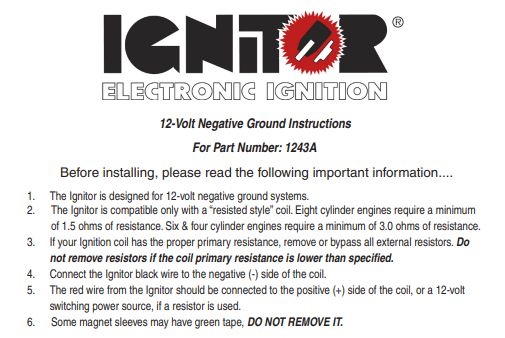|
Group: Forum Members
Last Active: Last Week
Posts: 764,
Visits: 113.4K
|
I think where Pertronix may be going with the 1.5 ohm minimum requirement is to protect the Pertronix device itself. After all, it too has it's current handling limitations. They are concerned with warranty issues. It's up to the end user to figure out what electrical values any particular coil needs. Yes, the 1.5 ohm coil marketed by Pertronix IS designed for the increased current and I personally have run that coil with no resistor and no issues for several years as other folks have done. If you try coils of unknown pedigree or specifications you may be asking for roadside trouble. Yes, any coil designed to be used with a resistor must be used accordantly. It almost always states on such coil: USE WITH EXTERNAL RESISTOR or something like that. So called 12V coils are 7 V coils because during cranking, the working voltage at the coil is still 7 +- volts when the resistor is bypassed by the starter solenoid so will produce full spark energy during the cranking event. I have, years ago, mocked up an entire ignition system to run on my distributor machine. Long interesting story shortened, by simply placing a jumper across the resistor, the sound and intensity increase of the spark was very obvious along with the fragrance of ozone. IMO, the best and safest setup is the 1.5 ohm Pertronis coil. That combo will produce energy far beyond any stock system with resistor and that has to be good for better cleaner combustion/fuel burn and all that.
64F100 57FAIRLANE500
|
|
Group: Forum Members
Last Active: 2 days ago
Posts: 20,
Visits: 1.0K
|
Here's a bit of conflicting info from Pertronix that came from a current document on their website. This is not the first time I have seen them doing this. Some may be caused by dated material. I think some of the uncertainty in whether to use or not use a ballast resistor comes from Pertronix selling three different versions of Ignitors, a standard Ignitor (formerly called called Ignitor I), an Ignitor II, and a Ignitor III. Pic 1. Note that one of the main differences is that Ignitor II and III have adaptive dwell. That's really not a true statement. It should say have adaptive dwell TIME. Dwell angle can't be changed, dwell time is constantly changing with engine RPM. At idle the dwell time is long and can overheat the coil. Speed it up and dwell time is extremely short, to the point of not fully saturating the coil with current. That, and point bounce will never allow a points system to be used for racing without doing major modifications such as dual points and increased point spring tension. So, go fast and the ignition misfires because of short dwell time. Go slow, and burn up the coil because of long dwell time. Pertronix II and III have adaptive dwell time control so using a ballast with them is not needed. Pertronix I does not, so there must be a balance between the ballast resistor and primary winding in the coil. Here is Pertronix's instructions on that. Pic 2
I think you have the right take on it. An 8 cylinder can use a 1.5 ohm or a 3.0 ohm coil without a ballast, but if it's not a performance issue use the 1.587% of original size (was 581x16) - Click to enlarge 87% of original size (was 581x16) - Click to enlarge 87% of original size (was 581x16) - Click to enlarge with a ballast. with a ballast.
|
|
Group: Forum Members
Last Active: 3 Years Ago
Posts: 513,
Visits: 153.3K
|
Pertronix Ignitor will handle a pretty wide range of voltages. It's nothing more than a Hall effect sensor/switch. What it can't handle though, is excessive current (heat).
This is why the total primary circuit resistance figure is important. I wouldn't say Pertronix info is contradictory, the problem is there are many different combinations that can be put together. People very often order the wrong parts. An ultra low 0.2 ohm resistance ignition coil paired with the original recipe series I ignitor, well, it isn't going to last very long.
You can figure it out for yourself using Ohm's Law.
|